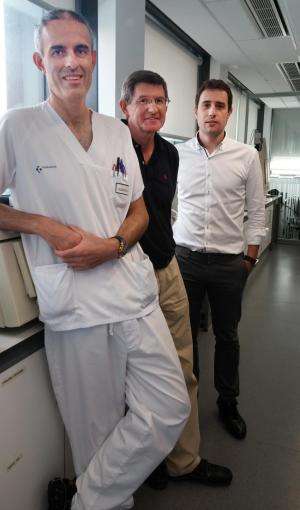Research shows that magnetic resonance helps to detect and quantify fat in liver

Obesity and overweight affect more than half of the population in our Community. Excess weight causes important alterations in the organism, one of which affects liver function. Fat accumulates in the liver producing hepatic steatosis which, in certain circumstances, causes inflammation, fibrosis and finally, cirrhosis. To date, the most reliable method for determining hepatic fat has been hepatic biopsy. Imaging techniques such as abdominal ecography detect it but are less precise for determining the quantity of fat.
But a study undertaken by the research team led by Luis Bujanda, Professor of Medicine at the University of the Basque Country (UPV/EHU) and in charge of the Area of Research into Hepatic and Gastrointestinal Diseases at the Biodonostia Health Research Institute, has shown that magnetic resonance is a good method - better still than hepatic biopsy - for detecting fats in the liver and for quantifying them. The work has been published in the BMC Medicine, one of the most important journals in the specialisation and coordinated by doctors Jesús Bañales of the Biodonostia HRI, and Raúl Jimenez of the Department of Surgery, Radiology and Physical Medicine at the UPV/EHU's Medicine and Odontology Faculty. The study also has had the participation of researchers from the Department of Nutrition and Food Sciences of the UPV/EHU's Pharmacy Faculty, from the Surgery, Digestive System and Pathological Anatomy Services at the Donostia University Hospital, together with Osatek (the Basque Public Health Department's Imaging Diagnosis Service).
The research was undertaken with 97 obese patients and 32 patients with other hepatic pathologies, and who had been subject to surgical intervention. The quantity of fat in the liver was measured using three different methods; magnetic resonance, hepatic biopsy and the biochemical determination of fat employing the Folch method. Patients were subject to magnetic resonance the day prior to surgery and a sample of liver was obtained during the surgery.
"Magnetic resonance is a very useful technique to determine the presence of fat or not in the liver, the quantity of the same and in order to evaluate the efficacy of treatment applied over a long period. It is possible that in the future we will be able to determine, apart from fat, the degree of inflammation and hepatic fibrosis.", stated Jesús Bañales, researcher at Biodonostia HRI.
The article, recently published in the BMC Medicine journal, ratifies the previous work undertaken in animals and published by the same research team a year ago in which it was observed that the quantification of hepatic fat was very precise when using magnetic resonance.
More information: Novel equation to determine the hepatic triglyceride concentration in humans by MRI: diagnosis and monitoring of NAFLD in obese patients before and after bariatric surgery. Raúl Jiménez-Agüero, José I Emparanza, Adolfo Beguiristain, Luis Bujanda, José M Alustiza, Elisabeth García, Elizabeth Hijona, Lander Gallego, Javier Sánchez-González, María J Perugorria, José I Asensio, Santiago Larburu, Maddi Garmendia, Mikel Larzabal, María P Portillo, Leixuri Aguirre and Jesús M Bañales. BMC Medicine 2014, 12:137. DOI: 10.1186/s12916-014-0137














